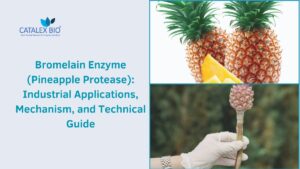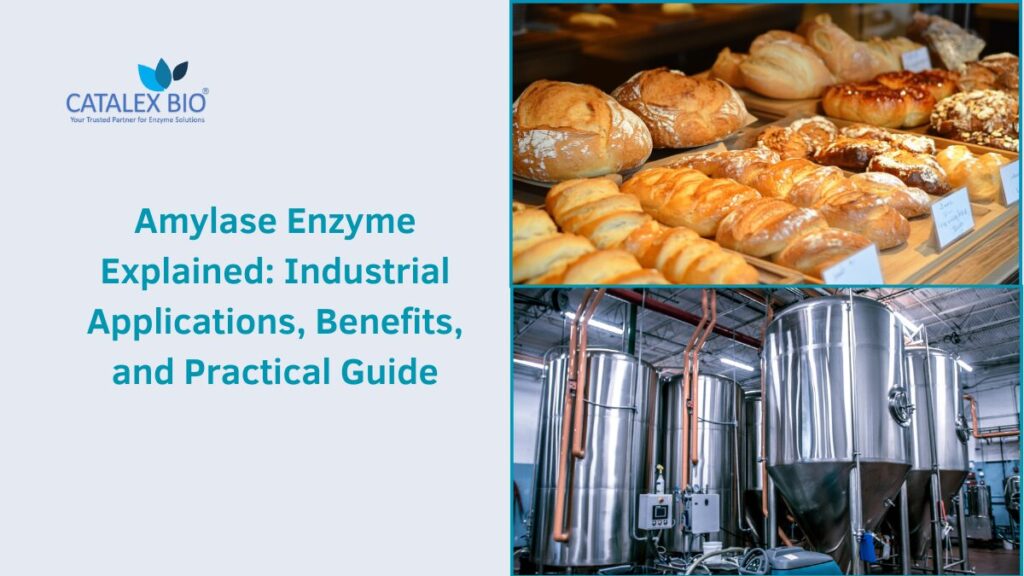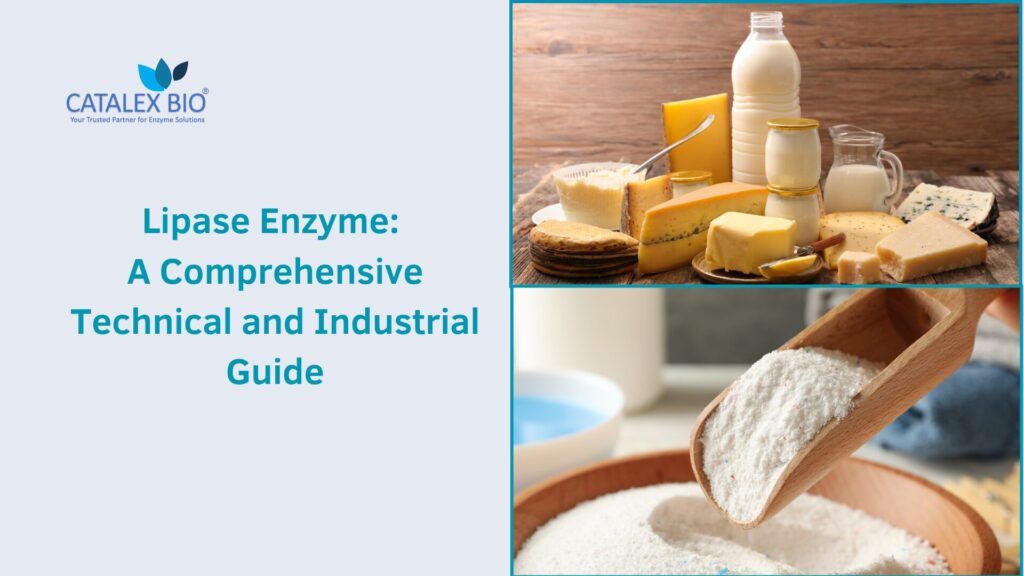1. Introduction
Enzymes have transformed modern biotechnology by replacing harsh chemical processes with eco-friendly, efficient, and highly selective biological catalysts. Among the many proteolytic enzymes that have found industrial and therapeutic applications, Bromelain occupies a unique niche. Unlike microbial or animal proteases, bromelain is a plant-derived enzyme complex, primarily sourced from the pineapple (Ananas comosus). This natural origin not only gives bromelain a strong acceptance in the food and nutraceutical industries but also aligns it with consumer demand for clean-label, sustainable, and plant-based processing aids.
Bromelain (EC 3.4.22.32) is not a single enzyme but rather a mixture of cysteine proteases and associated components, including phosphatases, peroxidases, glucosidases, cellulases, and glycoproteins. Its primary activity lies in proteolysis—the hydrolysis of peptide bonds in proteins—making it invaluable across industries where protein modification or digestion is required. Unlike bacterial or fungal proteases, bromelain’s plant-derived nature and broad substrate specificity make it suitable for both industrial-scale processes and therapeutic applications. Bromelain combines proteolytic activity with ancillary properties such as anti-inflammatory, fibrinolytic, immunomodulatory, and mucolytic effects.
Advantages of Bromelain
- Plant-derived origin → Appeals to “natural” and “vegan” markets.
- Broad substrate specificity → Effective on collagen, fibrin, casein, gelatin, keratin, and other proteins.
- Wide pH and temperature tolerance → Retains activity between pH 4–9 and up to ~60 °C.
- GRAS status (Generally Recognized as Safe) → Approved by FDA for food use.
- Dual role: Industrial + Therapeutic → Rare among enzymes to bridge both markets strongly.
At Catalex Bio, we provide high-quality bromelain customized for diverse applications. From food-grade powders for meat processing and beverage clarification to pharmaceutical-grade formulations for supplements and wound care, our bromelain solutions are backed by scientific validation, technical expertise, and reliable global supply chains.
This article offers a comprehensive technical and industrial guide to Bromelain, covering:
- History and discovery of bromelain
- Structure and mechanism of action
- Sources (fruit vs. stem, commercial forms)
- Industrial applications across food, pharma, cosmetics, and more
- Comparison with microbial proteases (fungal vs. bacterial)
- Units of activity and assay methods
- User guidance for industries and buyers
- Future outlook and innovations
By the end, you’ll understand why bromelain is one of the most versatile plant enzymes in biotechnology today, and how it can add value to industries seeking efficiency, sustainability, and performance.
2. History and Discovery of Bromelain
The history of bromelain reflects the intersection of traditional medicine and modern biotechnology.
Early Observations (Late 19th – Early 20th Century)
- 1891 – Bromelain was first identified in pineapple juice by the Venezuelan chemist Vicente Marcano.
- 1894 – Further studies confirmed that pineapple contained a proteolytic principle capable of hydrolyzing proteins.
- Early 20th Century – Stem-derived bromelain (now the major industrial source) was distinguished from fruit bromelain.
Mid 20th Century – Therapeutic and Industrial Exploration
- 1950s–1960s – Clinical studies in Europe highlighted bromelain’s anti-inflammatory and fibrinolytic effects, leading to its adoption as a natural therapeutic supplement.
- Food industries began testing bromelain for meat tenderization and beer clarification.
Late 20th Century – Standardization & Commercialization
- Advances in extraction and purification enabled large-scale production of bromelain from pineapple stem byproducts, turning agricultural waste into a high-value enzyme.
- The nutraceutical and cosmetic industries embraced bromelain for digestive health and skincare formulations.
Present Day – Biotechnological Advancements
- Bromelain is produced in standardized activity units (e.g., GDU, MCU, FIP units).
- Applications now extend to biomedical research, wound healing dressings, dental care, and combination therapies.
- Advances in immobilization and encapsulation are improving stability and controlled delivery.
3. Structure and Mechanism of Action of Bromelain
Bromelain is not a single enzyme but a complex mixture of proteolytic enzymes and accessory components, predominantly cysteine proteases. These proteases belong to the papain superfamily (clan CA, family C1A), characterized by their reliance on a cysteine–histidine catalytic dyad to hydrolyze peptide bonds.
3.1 Structure
- Catalytic residues: The active site contains a cysteine–histidine dyad.
- Molecular weight: Typically 20–37 kDa depending on isoforms and glycosylation.
- Isoenzymes: Commercial bromelain is a mixture of proteases, phosphatases, glycosidases, peroxidases, and cellulase-like enzymes, giving it multifunctional activity.
3.2 Mechanism of Action
- Substrate Binding – The protein substrate binds near the cysteine–histidine active site.
- Nucleophilic Attack – The thiol (-SH) group of cysteine attacks the carbonyl carbon of the peptide bond.
- Tetrahedral Intermediate – A covalent acyl-enzyme complex is formed.
- Bond Cleavage – The peptide bond is broken, releasing peptide fragments.
- Deacylation – Water regenerates the enzyme, freeing it for the next catalytic cycle.
3.3 Factors Affecting Bromelain Activity
- pH: Optimal activity at pH 5.5–8.0; stable in a wide range (4.0–9.0).
- Temperature: Active between 30–60 °C; denatures above 65 °C.
- Inhibitors: Sensitive to cysteine protease inhibitors (e.g., E-64, iodoacetamide, heavy metals).
- Stabilizers: Calcium ions, sugars, and polyols can enhance stability.
- Formulation: Freeze-dried or immobilized bromelain improves storage life and resistance to denaturation.
3.4 Unique Functional Properties
- Proteolysis under mild conditions: Unlike bacterial proteases that require alkaline or high-heat conditions, bromelain works efficiently at near-neutral pH and moderate temperatures.
- Broad substrate tolerance: Enables versatility across food, pharma, cosmetics, and feed applications.
- Dual activity (endopeptidase + exopeptidase): While mainly endopeptidase, bromelain preparations often show side activities like aminopeptidase, enhancing protein breakdown efficiency.
4. Sources of Bromelain
Bromelain occurs naturally in the pineapple plant (Ananas comosus), but its abundance and proteolytic activity vary depending on the part of the plant.
4.1 Fruit Bromelain
- Found in pineapple juice and fruit pulp.
- Exhibits lower proteolytic activity than stem bromelain.
- Historically studied for digestive aid and juice clarification, but not widely used industrially due to limited yields.
- More relevant in dietary supplements and small-scale food processing.
4.2 Stem Bromelain (Commercial Source)
- Extracted primarily from pineapple stems, which are byproducts of fruit processing.
- Higher proteolytic activity and more stable than fruit bromelain.
- Accounts for the majority of industrial bromelain production.
- Applications include meat tenderization, pharmaceuticals, nutraceuticals, cosmetics, and textiles.
- Sustainable sourcing: uses agricultural waste (stems) → adds value to pineapple processing chains.
4.3 Commercial Forms of Bromelain
- Crude extracts – less refined, used in industrial applications like meat tenderizing, leather bating, and textiles.
- Purified powders – standardized in GDU (Gelatin Digestion Units) or CDU (Casein Digestion Units), used in pharma, nutraceutical, and cosmetic industries.
- Liquid formulations – concentrated extracts for beverage clarification and certain food applications.
- Immobilized bromelain – under research for continuous processing in food hydrolysis and waste treatment.
4.4 Modern Biotechnology Sources
- Recombinant Expression: Efforts to express bromelain genes in microbial systems (E. coli, yeast, fungi) are underway to bypass dependency on pineapple crops.
- Immobilization & Stabilization: Research into immobilized bromelain on carriers (silica, chitosan, alginate) aims to improve reusability in continuous processing.
- Nanoformulations: Encapsulation in nanoparticles is being explored for drug delivery and enhanced stability in nutraceuticals
5. Industrial Applications of Bromelain
Bromelain is one of the few plant-derived proteases that has achieved wide-scale acceptance across multiple industries. Its ability to hydrolyze diverse proteins under mild, near-neutral conditions sets it apart from microbial alkaline proteases. Today, bromelain is used in food processing, pharmaceuticals, nutraceuticals, cosmetics, animal feed, leather, textiles, and even specialty industrial formulations.
5.1 Food Industry
Bromelain’s strongest reputation is in food processing, where its proteolytic activity enhances texture, clarity, and digestibility.
A. Meat Tenderization
- Breaks down collagen and muscle fiber proteins, softening tough cuts of meat.
- Applied either as a marinade ingredient, powder sprinkle, or injection solution.
- Results in improved juiciness, chewability, and consumer acceptance.
- Compared to bacterial proteases, bromelain acts more gently, reducing risk of over-hydrolysis or bitterness.
B. Protein Hydrolysates
- Produces protein hydrolysates for infant foods, sports nutrition, and flavor enhancers.
- Hydrolysates are easier to digest and often hypoallergenic.
- Bromelain yields mild-tasting hydrolysates, unlike microbial proteases that may create bitter peptides.
C. Bakery Applications
- Modifies gluten proteins in flour, improving dough extensibility and machinability.
- Improves loaf volume, crumb softness, and shelf-life by reducing gluten rigidity.
- Must be carefully dosed — excessive activity can weaken dough structure.
D. Beverage Clarification
- Breaks down protein haze in fruit juices (pineapple, apple, grape) and beer.
- Enhances clarity, improves shelf life, and prevents sedimentation.
- Competes with fungal proteases but has special value in tropical juice processing.
5.2 Pharmaceutical and Healthcare Industry
Bromelain has carved a unique position as a therapeutic enzyme, used in oral supplements, topical formulations, and even experimental medical treatments.
A. Anti-inflammatory and Analgesic
- Reduces pain, swelling, and bruising after surgery or trauma.
- Used in post-operative care, sinusitis, arthritis, and sports injury recovery.
- Works by modulating pro-inflammatory mediators and enhancing fibrinolysis.
B. Digestive Aid
- Functions similarly to pepsin and trypsin, helping break down dietary proteins.
- Included in multi-enzyme digestive formulations.
C. Wound Healing and Debridement
- Applied topically in ointments for burns, ulcers, and necrotic tissue removal.
- Breaks down dead proteins while sparing viable tissue.
D. Antithrombotic and Cardiovascular Benefits
- Exhibits mild anticoagulant and fibrinolytic activity, reducing risk of thrombosis.
- Studied as an adjunct in cardiovascular health supplements.
E. Oncology and Immune Support (Emerging)
- Research indicates bromelain may enhance drug absorption, suppress tumor metastasis, and regulate cytokines.
- Currently experimental but shows promise for adjunct cancer therapy.
5.3 Nutraceutical and Dietary Supplements
- Popular in capsules, tablets, and enzyme blends.
- Often combined with papain, amylase, or lipase in digestive health products.
- Sports nutrition blends use bromelain for muscle recovery and reduced inflammation.
- Standardized labeling usually in GDU (Gelatin Digestion Units).
5.4 Cosmetic and Personal Care Industry
Bromelain’s gentle but effective protein-hydrolyzing ability makes it ideal for skin and hair applications.
- Exfoliation: Breaks down keratin in dead skin cells, providing smoothness and radiance.
- Anti-inflammatory creams: Reduces redness, puffiness, and acne-related inflammation.
- Anti-aging formulations: Helps reduce roughness and promotes skin renewal.
- Cellulite reduction (claimed): Some formulations use bromelain to break down connective tissue proteins.
5.5 Leather and Textile Processing
Bromelain provides eco-friendly alternatives to harsh chemical treatments in processing hides, wool, and silk.
- Leather Bating: Removes non-collagen proteins and scud (hair residues) from hides, improving softness and grain quality.
- Wool Softening: Breaks down keratin, improving dye uptake and fabric softness.
- Silk Degumming: Replaces chemicals in removing sericin, producing smooth, lustrous silk.
6. Fungal vs. Bacterial Proteases: Where Does Bromelain Fit?
Bromelain is a plant-derived protease, primarily sourced from pineapple stems. In industrial practice, bromelain is often compared with fungal and bacterial proteases, which dominate commercial enzyme markets due to cost, scalability, and robustness. Understanding these differences helps industries decide when to choose bromelain versus microbial alternatives.
6. 1 Comparative Table: Fungal, Bacterial Proteases vs. Bromelain
| Parameter | Fungal Proteases | Bacterial Proteases | Bromelain (Plant) |
|---|---|---|---|
| Source | Aspergillus, Rhizopus (fungi) | Bacillus spp. (bacteria) | Pineapple stem & fruit (plant) |
| Optimal pH | 3.0–6.5 (acidic–neutral) | 7.5–11.0 (neutral–alkaline) | 5.5–7.5 (neutral) |
| Temp Range | 30–50 °C | 40–70 °C (thermophiles up to 90) | 30–60 °C |
| Stability | Moderate, acid-stable | High, thermo- & alkali-stable | Moderate; sensitive above 65 °C |
| Cost | Low (fermentation-based) | Very low (high-yield fermentation) | Higher (agricultural extraction) |
| Main Uses | Food, beverage, dairy | Detergents, leather, feed | Pharma, nutraceuticals, cosmetics, food |
| Advantages | GRAS, low cost, food-safe | Robust, scalable, industrially strong | Therapeutic benefits, “natural” label |
| Limitations | Heat-sensitive, limited industrial range | Bitter peptides, limited food use | Costly, less stable in harsh conditions |
6.2 Rule of Thumb for Industry Users
- Use fungal proteases → when working in acidic food processes (juices, baking, soy, cheese).
- Use bacterial proteases → for large-scale, alkaline, heavy-duty processes (detergents, leather, waste treatment, animal feed).
- Use bromelain → when therapeutic benefits, natural labeling, or specialized food/nutraceutical performance are required.
7. Units of Bromelain Activity Measurement
Activity is expressed in various units, depending on assay and supplier.
- GDU (Gelatin Digesting Unit):
1 GDU = amount of enzyme that digests 1 mg of gelatin in 20 min at 37 °C, pH 4.5.
Common in dietary supplements. - FIP Units (Federation Internationale Pharmaceutique):
Standardized for pharmaceutical-grade proteases. - Casein Digesting Units (CDU):
Based on hydrolysis of casein substrate.
Note: Units are not directly interchangeable; always confirm supplier assay conditions.
8. How Bromelain Activity is Measured (Assay Methods)
The choice of assay method for bromelain depends on its intended application (food, pharma, nutraceutical, research). Because bromelain is a protease with broad substrate specificity, activity assays typically measure its ability to hydrolyze proteins like gelatin or casein, or synthetic peptide substrates.
8.1 Gelatin Digestion Assay (GDU Method)
- Principle: Bromelain hydrolyzes gelatin into peptides and amino acids.
- Measurement: The extent of digestion is compared against a reference standard.
- Unit Basis: GDU (Gelatin Digestion Unit).
- Usage: Nutraceuticals and dietary supplements (standard for labeling).
- Pros/Cons:
- (+) Directly relevant to consumer supplement claims.
- (–) Crude and not precise for industrial quality control.
8.2 Casein Digestion Assay (CDU Method)
- Principle: Bromelain cleaves casein, releasing tyrosine and other aromatic amino acids.
- Measurement: Released tyrosine equivalents are quantified by spectrophotometry.
- Unit Basis: CDU (Casein Digestion Unit).
- Usage: Widely used in food processing (meat tenderization, baking, hydrolysates).
- Pros/Cons:
- (+) Quantitative and reliable for food enzyme QC.
- (–) Time-consuming compared to synthetic substrate assays.
8.3 FIP Casein Assay (Pharmaceutical Standard)
- Principle: Follows standardized International Pharmaceutical Federation (FIP) protocol for protease assays.
- Unit Basis: FIP Units.
- Usage: Pharmaceutical-grade bromelain intended for therapeutic use.
- Pros/Cons:
- (+) Globally recognized, pharmacopeia-compliant.
- (–) More complex and resource-intensive.
8.4 Spectrophotometric Assays (Synthetic Substrates)
- p-Nitrophenyl Esters (pNPP, pNPA): Release p-nitrophenol, measured at 405 nm.
- Chromogenic peptides: Linked to dyes (e.g., azo-casein, hemoglobin derivatives).
- Fluorogenic peptides: Release fluorescent compounds for high sensitivity.
- Usage: R&D labs, detergent enzyme QC, pharmaceutical research.
- Pros/Cons:
- (+) High sensitivity, suitable for high-throughput screening.
- (–) Less representative of natural protein hydrolysis.
9. Practical Guidance for Enzyme Users
- Select the Right Grade
- Food-grade → meat, brewing, baking.
- Pharma/nutraceutical-grade → anti-inflammatory, digestive aid.
- Industrial-grade → textiles, leather, cosmetics.
- Confirm Activity Units
- Check if supplier uses GDU, MCU, or FIP.
- Normalize dosage across suppliers.
- Storage & Handling
- Store at <25 °C, dry conditions.
- Hygroscopic – avoid moisture exposure.
- Shelf life: ~2 years if properly stored.
- Safety Precautions
- Dust inhalation may cause respiratory sensitization.
- Use PPE: gloves, mask, goggles.
- Follow MSDS guidelines.
- Regulatory Compliance
- Bromelain is GRAS (FDA) and approved by EFSA, FSSAI for food/nutraceutical use.
- Pharma use requires GMP-certified production.
10. Future Outlook and Innovations
- Immobilized Bromelain – for continuous bioreactors in food and pharma.
- Recombinant Production – scalable expression in microbes/plants to bypass pineapple dependency.
- Encapsulation & Nanodelivery – for enhanced oral bioavailability in nutraceuticals.
- Biomedical Innovations – enzymatic debridement gels, anti-cancer adjunct therapies.
- Synergistic Enzyme Formulations – bromelain combined with papain, trypsin, or amylases for multi-functional blends.
- Expansion in Green Chemistry – eco-friendly textiles, biodegradable materials.
11. Conclusion
Bromelain has evolved from a traditional meat tenderizer to a multi-industry biocatalyst with applications spanning food, nutraceuticals, pharmaceuticals, cosmetics, and more. Unlike microbial proteases that dominate bulk industrial sectors, bromelain occupies a specialized, high-value niche, thanks to its broad substrate specificity, therapeutic benefits, and natural plant origin.
🔑 Key takeaways:
- Fungal proteases are suited for acidic food processes.
- Bacterial proteases dominate alkaline and high-temperature industries.
- Bromelain stands out where “natural,” “therapeutic,” and “clean-label” advantages matter most.
Understanding assay methods, activity units, and correct dosing is critical for maximizing bromelain’s efficiency in different applications. With proper sourcing, handling, and application strategies, bromelain can deliver performance, consistency, and sustainability across industries.
At Catalex Bio, we are committed to providing scientifically validated bromelain solutions, tailored to the unique needs of our global customers. Whether your goal is enhancing food processing, formulating nutraceuticals, developing pharmaceuticals, or adopting sustainable industrial processes, our expertise and reliable enzyme portfolio ensure that bromelain delivers the performance and trust your business requires.
Reach out to us to explore our bromelain enzyme solutions or to discuss customized applications for your industry.



